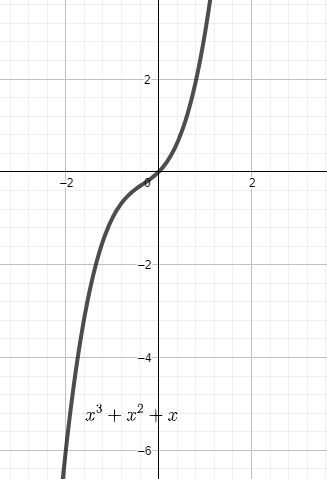
How do you find the critical numbers for $f\left( x \right)={{x}^{3}}+{{x}^{2}}+x$ to determine the maximum and the minimum?
Answer
546k+ views
Hint: We find the slope of the given function $f\left( x \right)={{x}^{3}}+{{x}^{2}}+x$. We equate it with 0. Extremum points in a curve have slope value 0. We solve the quadratic solution to find the coordinates and the points.
Complete step by step answer:
We need to find the relative extrema of the function $f\left( x \right)={{x}^{3}}+{{x}^{2}}+x$.
To find the extremum points we need to find the slope of the function and also the value of the point where the slope will be 0.
Extremum points in a curve have slope value 0.
The slope of the function $f\left( x \right)={{x}^{3}}+{{x}^{2}}+x$ can be found from the derivative of the function ${{f}^{'}}\left( x \right)=\dfrac{d}{dx}\left[ f\left( x \right) \right]$.
We differentiate both sides of the function $f\left( x \right)={{x}^{3}}+{{x}^{2}}+x$ with respect to $x$.
$\begin{align}
& f\left( x \right)={{x}^{3}}+{{x}^{2}}+x \\
& \Rightarrow {{f}^{'}}\left( x \right)=\dfrac{d}{dx}\left[ f\left( x \right) \right]=\dfrac{d}{dx}\left[ {{x}^{3}}+{{x}^{2}}+x \right] \\
\end{align}$.
We know that the differentiation form for ${{n}^{th}}$ power of $x$ is $\dfrac{d}{dx}\left[ {{x}^{n}} \right]=n{{x}^{n-1}}$.
Therefore, ${{f}^{'}}\left( x \right)=\dfrac{d}{dx}\left( {{x}^{3}} \right)+\dfrac{d}{dx}\left( {{x}^{2}} \right)+\dfrac{d}{dx}\left( x \right)=3{{x}^{2}}+2x+1$.
To find the $x$ coordinates of the extremum points we take $3{{x}^{2}}+2x+1=0$.
We know for a general equation of quadratic $a{{x}^{2}}+bx+c=0$, the value of the roots of x will be $x=\dfrac{-b\pm \sqrt{{{b}^{2}}-4ac}}{2a}$.
In the given equation we have $3{{x}^{2}}+2x+1=0$. The values of $a,b,c$ is $3,2,1$ respectively.
We put the values and get $x$ as $x=\dfrac{-2\pm \sqrt{{{2}^{2}}-4\times 1\times 3}}{2\times 3}=\dfrac{-2\pm \sqrt{-8}}{6}=\dfrac{-1\pm i\sqrt{2}}{3}$.
The roots of the slope are imaginary which means the curve $f\left( x \right)={{x}^{3}}+{{x}^{2}}+x$ has no extremum values.
${{f}^{'}}\left( x \right)=3{{x}^{2}}+2x+1$ is equation with value being greater than 0 as $3{{x}^{2}}+2x+1=2{{x}^{2}}+{{\left( x+1 \right)}^{2}}$ is sum of squares. So, ${{f}^{'}}\left( x \right)=3{{x}^{2}}+2x+1>0$.
In no points of the curve $f\left( x \right)={{x}^{3}}+{{x}^{2}}+x$ has slope value 0.
Note: We can also prove it from the graph of the curve $f\left( x \right)={{x}^{3}}+{{x}^{2}}+x$. This is an increasing function. There is no sharp curve in the graph to have slope 0.

Complete step by step answer:
We need to find the relative extrema of the function $f\left( x \right)={{x}^{3}}+{{x}^{2}}+x$.
To find the extremum points we need to find the slope of the function and also the value of the point where the slope will be 0.
Extremum points in a curve have slope value 0.
The slope of the function $f\left( x \right)={{x}^{3}}+{{x}^{2}}+x$ can be found from the derivative of the function ${{f}^{'}}\left( x \right)=\dfrac{d}{dx}\left[ f\left( x \right) \right]$.
We differentiate both sides of the function $f\left( x \right)={{x}^{3}}+{{x}^{2}}+x$ with respect to $x$.
$\begin{align}
& f\left( x \right)={{x}^{3}}+{{x}^{2}}+x \\
& \Rightarrow {{f}^{'}}\left( x \right)=\dfrac{d}{dx}\left[ f\left( x \right) \right]=\dfrac{d}{dx}\left[ {{x}^{3}}+{{x}^{2}}+x \right] \\
\end{align}$.
We know that the differentiation form for ${{n}^{th}}$ power of $x$ is $\dfrac{d}{dx}\left[ {{x}^{n}} \right]=n{{x}^{n-1}}$.
Therefore, ${{f}^{'}}\left( x \right)=\dfrac{d}{dx}\left( {{x}^{3}} \right)+\dfrac{d}{dx}\left( {{x}^{2}} \right)+\dfrac{d}{dx}\left( x \right)=3{{x}^{2}}+2x+1$.
To find the $x$ coordinates of the extremum points we take $3{{x}^{2}}+2x+1=0$.
We know for a general equation of quadratic $a{{x}^{2}}+bx+c=0$, the value of the roots of x will be $x=\dfrac{-b\pm \sqrt{{{b}^{2}}-4ac}}{2a}$.
In the given equation we have $3{{x}^{2}}+2x+1=0$. The values of $a,b,c$ is $3,2,1$ respectively.
We put the values and get $x$ as $x=\dfrac{-2\pm \sqrt{{{2}^{2}}-4\times 1\times 3}}{2\times 3}=\dfrac{-2\pm \sqrt{-8}}{6}=\dfrac{-1\pm i\sqrt{2}}{3}$.
The roots of the slope are imaginary which means the curve $f\left( x \right)={{x}^{3}}+{{x}^{2}}+x$ has no extremum values.
${{f}^{'}}\left( x \right)=3{{x}^{2}}+2x+1$ is equation with value being greater than 0 as $3{{x}^{2}}+2x+1=2{{x}^{2}}+{{\left( x+1 \right)}^{2}}$ is sum of squares. So, ${{f}^{'}}\left( x \right)=3{{x}^{2}}+2x+1>0$.
In no points of the curve $f\left( x \right)={{x}^{3}}+{{x}^{2}}+x$ has slope value 0.
Note: We can also prove it from the graph of the curve $f\left( x \right)={{x}^{3}}+{{x}^{2}}+x$. This is an increasing function. There is no sharp curve in the graph to have slope 0.

Recently Updated Pages
Basicity of sulphurous acid and sulphuric acid are

Master Class 12 Business Studies: Engaging Questions & Answers for Success

Master Class 12 Economics: Engaging Questions & Answers for Success

Master Class 12 English: Engaging Questions & Answers for Success

Master Class 12 Maths: Engaging Questions & Answers for Success

Master Class 12 Social Science: Engaging Questions & Answers for Success

Trending doubts
What are the major means of transport Explain each class 12 social science CBSE

Which are the Top 10 Largest Countries of the World?

Draw a labelled sketch of the human eye class 12 physics CBSE

How much time does it take to bleed after eating p class 12 biology CBSE

Explain sex determination in humans with line diag class 12 biology CBSE

Differentiate between homogeneous and heterogeneous class 12 chemistry CBSE




